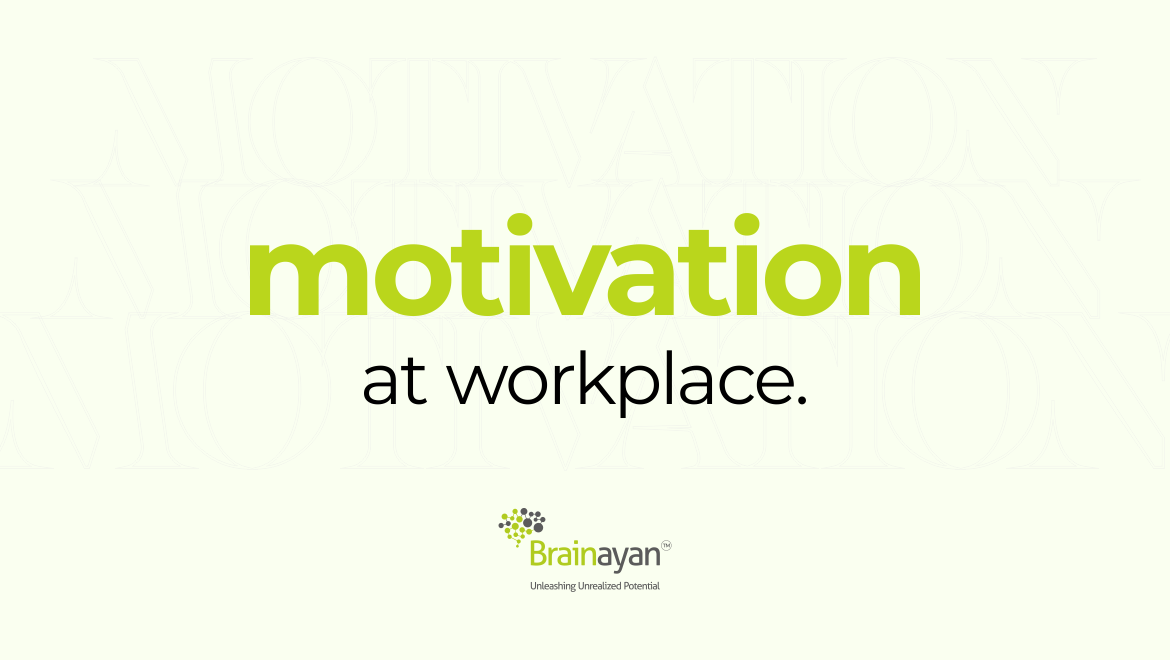Motivation at Workplace

Many employers aspire to have motivated and engaged employees, but often lack a deep understanding of what truly drives individual motivation (Burton, 2012). Today, organizations are faced with a diverse multi-generational workforce that necessitates the implementation of varied strategies to effectively motivate employees, enhance their job engagement, and maximize job satisfaction (Cote, 2019).
While monetary incentives and compensation are commonly associated with motivation in the workplace, it is important to recognize that financial motivation, being an extrinsic factor, may not have long-lasting effects as organizations anticipate. In fact, a study conducted by McKinsey revealed that three nonfinancial incentives – praise from immediate managers, attention from leaders, and opportunities to lead projects – were found to be even more effective motivators than the highest-rated financial incentives, including performance-based cash bonuses, base pay increases, and stocks. These nonfinancial motivators tap into employees’ intrinsic needs for autonomy, competence, and relatedness, which are fundamental drivers of motivation and job satisfaction. By prioritizing these non-monetary incentives alongside financial rewards, organizations can create a more holistic and sustainable motivational framework that resonates with employees on a deeper level.
According to the Herzberg’s Two-Factor Theory, financial factors such as salary and benefits fall under the category of hygiene factors. These factors are essential to prevent dissatisfaction in the workplace, but they alone are not sufficient to create motivation and satisfaction among employees. On the other hand, motivators, as identified by Herzberg, are factors that contribute to employee satisfaction and intrinsic motivation. These factors include achievements, recognition, opportunities for advancement, responsibility, and personal growth. Motivators are related to the nature of the work itself, the sense of accomplishment derived from it, and the recognition and growth opportunities associated with it. According to Herzberg’s theory, organizations need to address both hygiene factors and motivators to create a motivating work environment.
Additionally, this is also true with respect to the Maslow’s hierarchy of needs when it is connected to workplace motivation. Maslow’s theory proposes that individuals have a hierarchical set of needs that must be satisfied in a specific order. The needs are arranged in a pyramid structure, with lower-level needs at the base and higher-level needs at the top. At the foundational level, employees require basic physiological needs such as employment, salary, and financial security to ensure their survival and well-being. These needs are essential for employees to feel secure and stable in their lives, enabling them to focus on higher-level needs. The higher-level needs include psychological, and self-fulfilment needs, such as the need for praise, recognition, achievement, respect, and personal growth. These higher-level needs are considered intrinsic motivators as they are related to self-esteem, self-actualization, and personal fulfilment. It’s important for organizations to understand that while addressing basic needs is crucial, it is equally important to create a motivational environment that supports the fulfilment of higher-level needs.
Furthermore, In 1971, Harry Harlow and Edward Deci’s research findings highlighted that rewards alone may not effectively motivate and engage individuals and could even have negative effects on tasks being performed. This emphasizes the importance of fostering intrinsic motivation alongside extrinsic or rewards-based motivation. Daniel Pink, in his book titled ‘Drive’, identified three key factors that contribute to intrinsic motivation: autonomy, mastery, and purpose.
- Autonomy emphasizes the need for individuals to have control over their own work and lives. To be fully motivated, employees should have the freedom to decide what they do and when they do it. Providing autonomy allows individuals to feel a sense of ownership and empowerment, leading to increased motivation and engagement.
- Mastery relates to the desire to continuously improve and develop skills. Individuals who are motivated by mastery strive to enhance their performance and achieve personal growth. Fostering a culture that supports learning, provides opportunities for skill development, and encourages mastery helps individuals stay engaged and motivated.
- Purpose refers to understanding how one’s work contributes to a larger purpose or meaningful outcome. When employees grasp the significance of their contributions and can connect their work to a bigger picture, they are more likely to feel engaged and motivated.
While extrinsic rewards certainly have their place, they should be complemented with efforts to foster intrinsic motivation to drive sustained and meaningful engagement among employees.
Research has focused on optimizing an effective and systematic process for motivating the employees. Understanding of individual differences is the most complex component of this process because managers have to deal with human behavior constantly. However, without a complete understanding of this vital element of employee motivation, managers may design and develop motivators that reward wrong behaviors or motivators that do not affect employee motivation at all (Kim, 2006). While developing and implementing motivational strategies, organisations also need to consider personal factors (attitudes, values, needs, work ethic, emotions, and personality), contextual factors (organizational structure, pay, compensation, benefits, rewards, team norms, interpersonal relationships, and job design), intrinsic rewards (internal drivers), and extrinsic rewards (external driver).
Therefore, here are some best practices to motivate employees in pocket-friendly ways!
- Reward and recognize an employee immediately after they have performed an action to reinforce repetition of favourable behavior (Cote, 2019).
- Work on recognizing employees based on individual and generational preferences. For example, the older generations prefer to share their recognition with family and friends. Millennials tend to enjoy the novel experience eating at an exclusive restaurant. Baby Boomers prefer a formal recognition in front of employees while Gen X prefers recognition in a small group in a private setting. (Schweyer, 2015). In this way, find a way to address generational needs, for motivation, and customise your recognition strategies accordingly.
- By providing flexible working options and work-life balance organisations can increase the engagement of their employees (BasuMallick, 2018; Cote, 2019).
- Create a more diversified job profile, so that employees get to work on a variety of tasks. Encourage your employees to expand their job responsibilities to develop new competencies.
- If possible, granting additional autonomy and authority to employees in their daily tasks (Ball, 2012).
- Provide growth opportunities to employees. If growth opportunities are not provided to employees, they may regress to relatedness needs, and socialise more with co-workers. If you can recognise these conditions early , steps can be taken to satisfy the frustrated needs until the employee is able to pursue growth again (Ball, 2012).
- Create a challenging yet cooperative environment for your employees (Ball, 2012).
- Conduct quality circles with your employees to take their inputs on various issues. When employees are able to give their input to management, it makes them feel as though their opinion is valued and their work is crucial to the organization. Through these quality groups and meetings with management, the employees are able to create meaningful relationships in the workplace which can be a good motivator (Burton, 2012).
- Rethink traditional ideas of control at workplace like dress codes, regular office hours, numerical targets and redefine these while giving more autonomy to the employees. Encourage the employees to explore their style of working based on the strengths and skills they bring to the table apart from delivering just the work.
- Involve people in setting their own goals. Employees feel more connected to their work when they have worked on creating their targets and goals.
- Create an environment where employees can move between functions and choose the skills that they want to learn.
- Help your employees connect their strengths, personal goals, vision, and ideologies to the organization’s targets, purpose.
Remember, sometimes the simplest gestures and actions can have a profound impact on employee motivation and morale!
References:
Cote, R. (2019). Motivating Multigenerational Employees: Is There a Difference?. Journal of Leadership, Accountability and Ethics, 16(2), 15-29.
Burton, K. (2012). A study of motivation: How to get your employees moving. Management, 3(2), 232-234.
Kim, D. (2006). Employee motivation:“Just ask your employees”. Seoul Journal of Business, 12(1), 19-35.
Ball, B. (2012). A summary of motivation theories. Retrieved on www. yourcoach. be> uploads, 3.
Schweyer A. (2015). Generations in the workforce & marketplace: Preferences in rewards, recognition & incentives. Incentive Research Foundation. Retrieved from http://theirf.org/research/generations-in-the-workforce-marketplacepreferences-in-rewardsrecognition-incentives/1427/
https://www.mindtools.com/asmdp60/pinks-autonomy-mastery-and-purpose-framework

With a master’s in clinical psychology, Aasawari specializes in behaviour and mindset change, leveraging her understanding human behaviour to bring about personal and professional transformations. As a passionate researcher, she delves into the latest studies and findings to create insightful and evidence-based blog articles. She strives to bridge the gap between theory and practice by simplifying complex research to provide practically actionable recommendations.